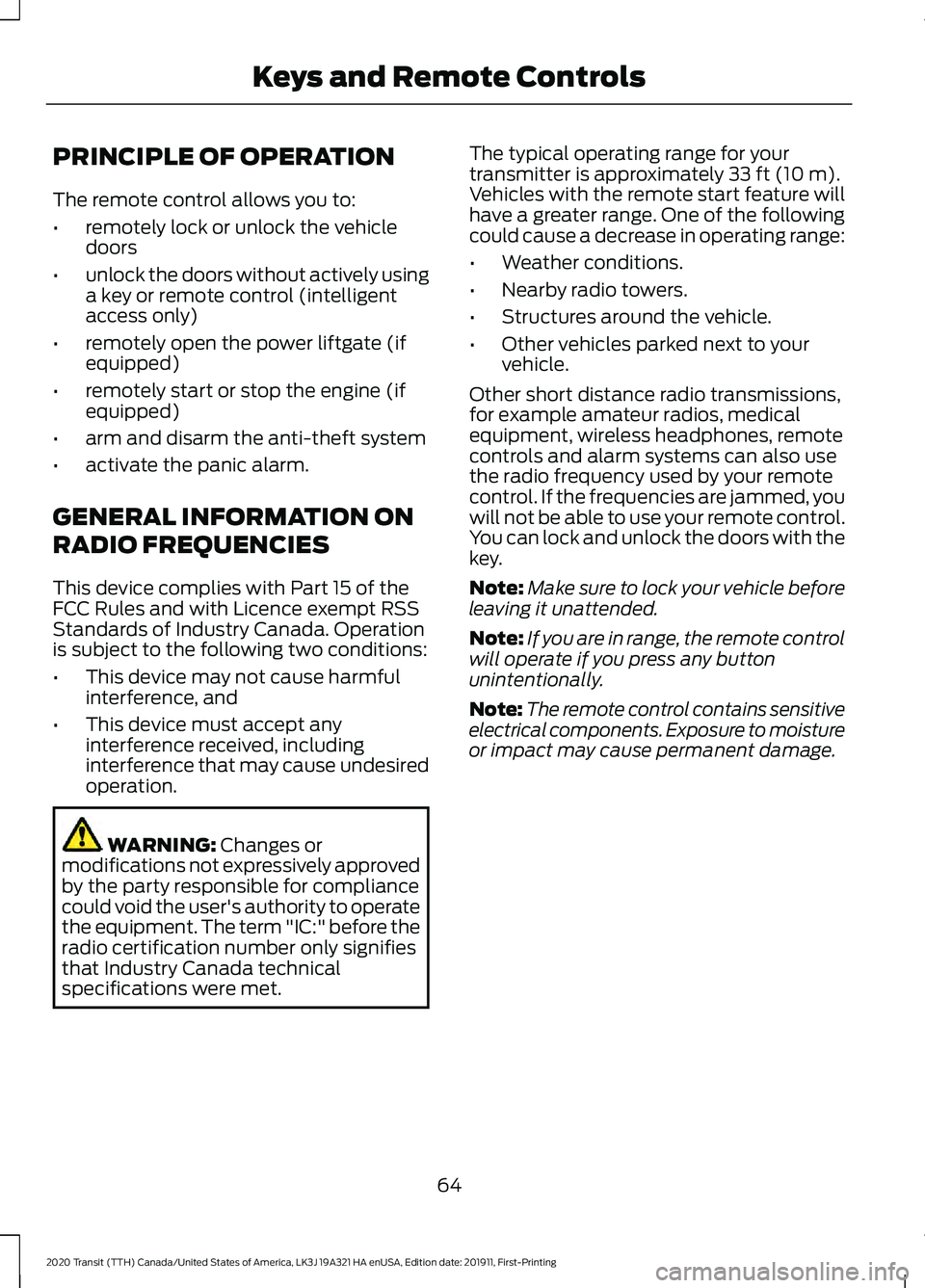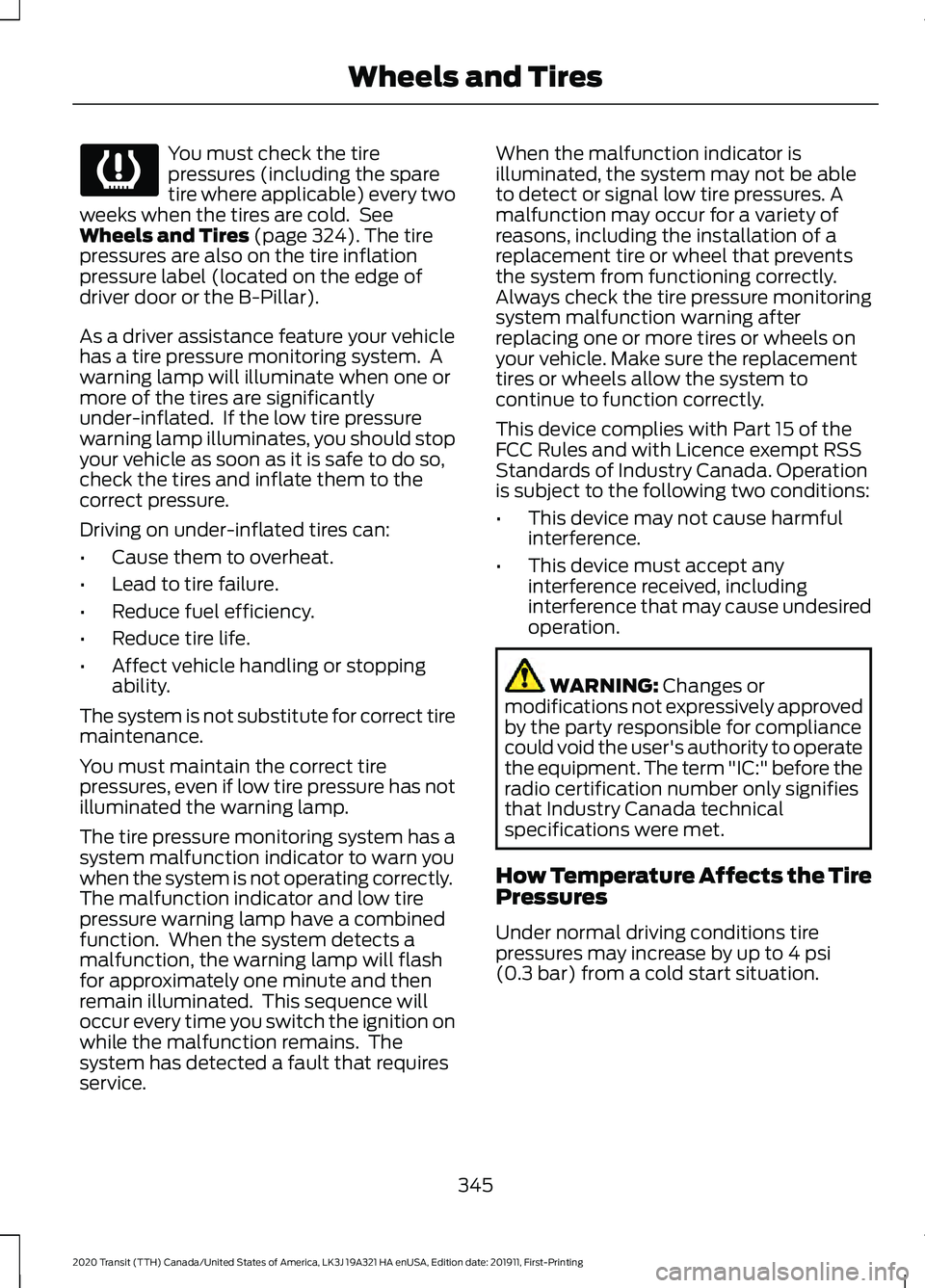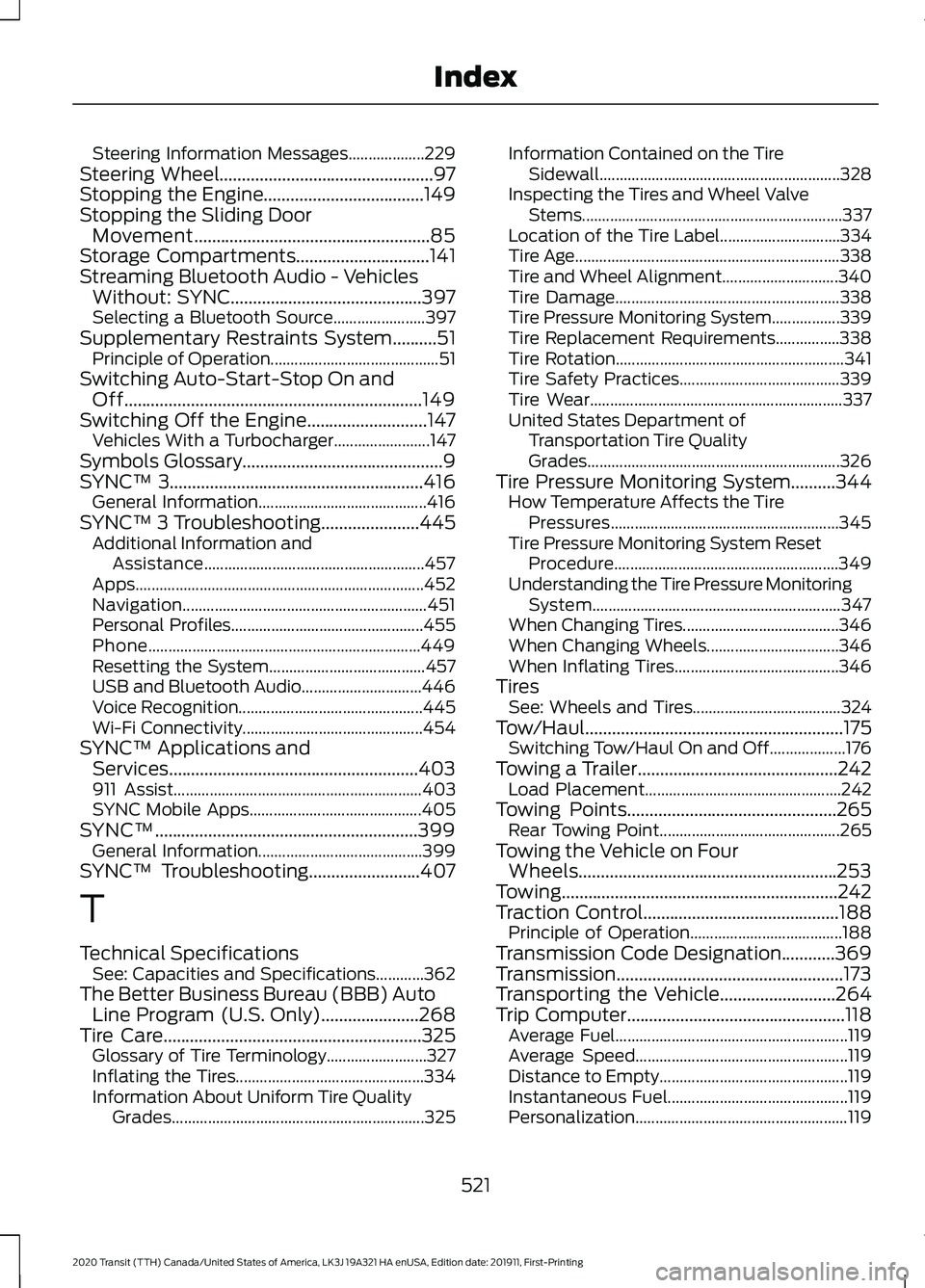technical specifications FORD TRANSIT 2020 Owners Manual
[x] Cancel search | Manufacturer: FORD, Model Year: 2020, Model line: TRANSIT, Model: FORD TRANSIT 2020Pages: 529, PDF Size: 8.3 MB
Page 67 of 529

PRINCIPLE OF OPERATION
The remote control allows you to:
•
remotely lock or unlock the vehicle
doors
• unlock the doors without actively using
a key or remote control (intelligent
access only)
• remotely open the power liftgate (if
equipped)
• remotely start or stop the engine (if
equipped)
• arm and disarm the anti-theft system
• activate the panic alarm.
GENERAL INFORMATION ON
RADIO FREQUENCIES
This device complies with Part 15 of the
FCC Rules and with Licence exempt RSS
Standards of Industry Canada. Operation
is subject to the following two conditions:
• This device may not cause harmful
interference, and
• This device must accept any
interference received, including
interference that may cause undesired
operation. WARNING: Changes or
modifications not expressively approved
by the party responsible for compliance
could void the user's authority to operate
the equipment. The term "IC:" before the
radio certification number only signifies
that Industry Canada technical
specifications were met. The typical operating range for your
transmitter is approximately
33 ft (10 m).
Vehicles with the remote start feature will
have a greater range. One of the following
could cause a decrease in operating range:
• Weather conditions.
• Nearby radio towers.
• Structures around the vehicle.
• Other vehicles parked next to your
vehicle.
Other short distance radio transmissions,
for example amateur radios, medical
equipment, wireless headphones, remote
controls and alarm systems can also use
the radio frequency used by your remote
control. If the frequencies are jammed, you
will not be able to use your remote control.
You can lock and unlock the doors with the
key.
Note: Make sure to lock your vehicle before
leaving it unattended.
Note: If you are in range, the remote control
will operate if you press any button
unintentionally.
Note: The remote control contains sensitive
electrical components. Exposure to moisture
or impact may cause permanent damage.
64
2020 Transit (TTH) Canada/United States of America, LK3J 19A321 HA enUSA, Edition date: 201911, First-Printing Keys and Remote Controls
Page 348 of 529

You must check the tire
pressures (including the spare
tire where applicable) every two
weeks when the tires are cold. See
Wheels and Tires (page 324). The tire
pressures are also on the tire inflation
pressure label (located on the edge of
driver door or the B-Pillar).
As a driver assistance feature your vehicle
has a tire pressure monitoring system. A
warning lamp will illuminate when one or
more of the tires are significantly
under-inflated. If the low tire pressure
warning lamp illuminates, you should stop
your vehicle as soon as it is safe to do so,
check the tires and inflate them to the
correct pressure.
Driving on under-inflated tires can:
• Cause them to overheat.
• Lead to tire failure.
• Reduce fuel efficiency.
• Reduce tire life.
• Affect vehicle handling or stopping
ability.
The system is not substitute for correct tire
maintenance.
You must maintain the correct tire
pressures, even if low tire pressure has not
illuminated the warning lamp.
The tire pressure monitoring system has a
system malfunction indicator to warn you
when the system is not operating correctly.
The malfunction indicator and low tire
pressure warning lamp have a combined
function. When the system detects a
malfunction, the warning lamp will flash
for approximately one minute and then
remain illuminated. This sequence will
occur every time you switch the ignition on
while the malfunction remains. The
system has detected a fault that requires
service. When the malfunction indicator is
illuminated, the system may not be able
to detect or signal low tire pressures. A
malfunction may occur for a variety of
reasons, including the installation of a
replacement tire or wheel that prevents
the system from functioning correctly.
Always check the tire pressure monitoring
system malfunction warning after
replacing one or more tires or wheels on
your vehicle. Make sure the replacement
tires or wheels allow the system to
continue to function correctly.
This device complies with Part 15 of the
FCC Rules and with Licence exempt RSS
Standards of Industry Canada. Operation
is subject to the following two conditions:
•
This device may not cause harmful
interference.
• This device must accept any
interference received, including
interference that may cause undesired
operation. WARNING:
Changes or
modifications not expressively approved
by the party responsible for compliance
could void the user's authority to operate
the equipment. The term "IC:" before the
radio certification number only signifies
that Industry Canada technical
specifications were met.
How Temperature Affects the Tire
Pressures
Under normal driving conditions tire
pressures may increase by up to
4 psi
(0.3 bar) from a cold start situation.
345
2020 Transit (TTH) Canada/United States of America, LK3J 19A321 HA enUSA, Edition date: 201911, First-Printing Wheels and Tires
Page 511 of 529

Services even if Intelematics or a Supplier
has been advised of the possibility of such
damages. You also acknowledge that the
neither Intelematics nor any Supplier
guarantees nor make any warranties that
relate to the availability, accuracy or
completeness of SUNA Products and/or
Services, and to the extent which it is
lawful to do so, both Intelematics and each
Supplier excludes any warranties which
might otherwise be implied by any State
or Federal legislation in relation to SUNA
Products and/or Services.
7. Please Note
Great care has been taken in preparing this
manual. Constant product development
may mean that some information is not
entirely up-to-date. The information in this
document is subject to change without
notice.
DECLARATION OF CONFORMITY
Radio Frequency Statement IC Identification Number
FCC Identification Number
SYNC Version
216B-SYNCG3-L
ACJ-SYNCG3-L
3.0
216B-FA170BCARHS
ACJ-FA-170-BCARHS
3.1
216B-FG185SG32MH
ACJ-FG-185-SG32MH
3.2 WARNING: Changes or
modifications not expressively approved
by the party responsible for compliance
could void the user's authority to operate
the equipment. The term "IC:" before the
radio certification number only signifies
that Industry Canada technical
specifications were met.
These devices comply with Part 15 of the
FCC Rules and with RSS-210 of Industry
Canada. Operation is subject to the
following two conditions:
1. The device does not cause harmful interference.
2. The device accepts any interference received, including interference that
could cause undesired operation.
508
2020 Transit (TTH) Canada/United States of America, LK3J 19A321 HA enUSA, Edition date: 201911, First-Printing Appendices
Page 524 of 529

Steering Information Messages...................
229
Steering Wheel................................................97
Stopping the Engine....................................149
Stopping the Sliding Door Movement.....................................................85
Storage Compartments
..............................141
Streaming Bluetooth Audio - Vehicles Without: SYNC...........................................397
Selecting a Bluetooth Source....................... 397
Supplementary Restraints System
..........51
Principle of Operation.......................................... 51
Switching Auto-Start-Stop On and Off...................................................................149
Switching Off the Engine...........................147 Vehicles With a Turbocharger........................ 147
Symbols Glossary
.............................................9
SYNC™ 3.........................................................416 General Information.......................................... 416
SYNC™ 3 Troubleshooting......................445 Additional Information and
Assistance....................................................... 457
Apps........................................................................\
452
Navigation............................................................. 451
Personal Profiles................................................ 455
Phone
.................................................................... 449
Resetting the System....................................... 457
USB and Bluetooth Audio.............................. 446
Voice Recognition.............................................. 445
Wi-Fi Connectivity............................................. 454
SYNC™ Applications and Services........................................................403
911 Assist.............................................................. 403
SYNC Mobile Apps........................................... 405
SYNC™...........................................................399 General Information......................................... 399
SYNC™ Troubleshooting
.........................407
T
Technical Specifications See: Capacities and Specifications............362
The Better Business Bureau (BBB) Auto Line Program (U.S. Only)......................268
Tire Care..........................................................325 Glossary of Tire Terminology......................... 327
Inflating the Tires............................................... 334
Information About Uniform Tire Quality Grades............................................................... 325Information Contained on the Tire
Sidewall............................................................ 328
Inspecting the Tires and Wheel Valve Stems ................................................................. 337
Location of the Tire Label.............................. 334
Tire Age.................................................................. 338
Tire and Wheel Alignment............................. 340
Tire Damage........................................................ 338
Tire Pressure Monitoring System.................339
Tire Replacement Requirements................338
Tire Rotation......................................................... 341
Tire Safety Practices........................................ 339
Tire Wear............................................................... 337
United States Department of Transportation Tire Quality
Grades............................................................... 326
Tire Pressure Monitoring System..........344 How Temperature Affects the Tire
Pressures......................................................... 345
Tire Pressure Monitoring System Reset Procedure........................................................ 349
Understanding the Tire Pressure Monitoring System.............................................................. 347
When Changing Tires....................................... 346
When Changing Wheels................................. 346
When Inflating Tires......................................... 346
Tires See: Wheels and Tires..................................... 324
Tow/Haul..........................................................175 Switching Tow/Haul On and Off................... 176
Towing a Trailer
.............................................242
Load Placement................................................. 242
Towing Points
...............................................265
Rear Towing Point............................................. 265
Towing the Vehicle on Four Wheels..........................................................253
Towing..............................................................242
Traction Control............................................188 Principle of Operation...................................... 188
Transmission Code Designation............369
Transmission...................................................173
Transporting the Vehicle
..........................264
Trip Computer.................................................118 Average Fuel.......................................................... 119
Average Speed..................................................... 119
Distance to Empty............................................... 119
Instantaneous Fuel............................................. 119
Personalization..................................................... 119
521
2020 Transit (TTH) Canada/United States of America, LK3J 19A321 HA enUSA, Edition date: 201911, First-Printing Index